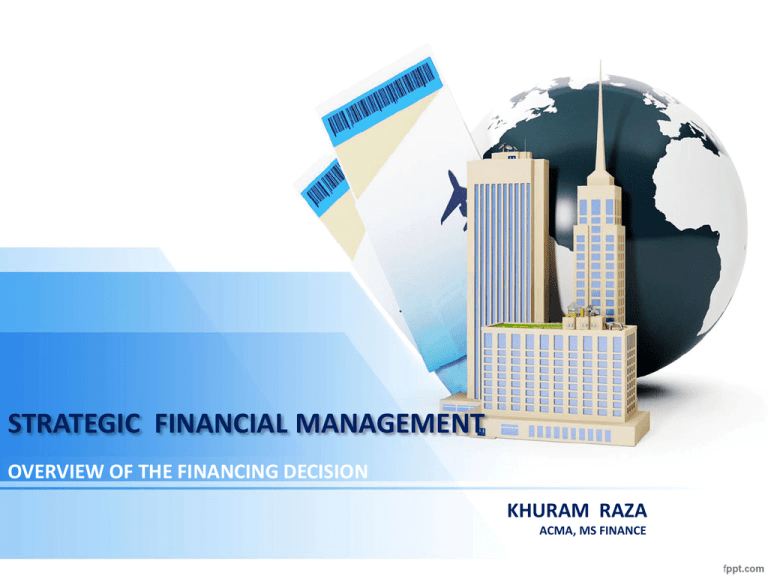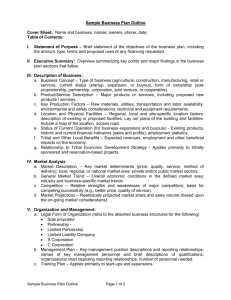SFM L09 - WordPress.com
advertisement

STRATEGIC FINANCIAL MANAGEMENT OVERVIEW OF THE FINANCING DECISION KHURAM RAZA ACMA, MS FINANCE First Principle and Big Picture The Choices: Types of Financing There are only two ways in which any business can raise money Debt or Equity. This may seem simplistic, given the array of choices firms have in terms of financing vehicles. We will begin this section with a discussion of the characteristics of debt and equity and then look at a range of financing vehicles available within each of these categories. We will then examine of a range of securities that share some characteristics with debt and some with equity and are therefore called hybrid securities. The Continuum between Debt and Equity Debt is defined as any financing vehicle that is a contractual claim on the firm (and not a function of its operating performance), creates tax-deductible payments, has a fixed life, and has a priority claim on cash flows in both operating periods and in bankruptcy. Equity is defined as any financing vehicle that is a residual claim on the firm, does not create a tax advantage from its payments, has an infinite life, does not have priority in bankruptcy, and provides management control to the owner. The Continuum between Debt and Equity Fixed Claim Tax Deductible High Priority in Financial Trouble Fixed Maturity No Management Control Debt Residual Claim Not Tax Deductible Lowest Priority in Financial Trouble Infinite Management Control Equity Debt and Equity Fixed Claim Tax Deductible High Priority in Financial Trouble Fixed Maturity No Management Control Residual Claim Not Tax Deductible Lowest Priority in Financial Trouble Infinite Management Control Debt Bank Debt Corporate Bonds Leases Equity Hybrid Securities Convertible Debt Preferred Stock Option-linked Bonds Owner’s Equity Venture Capital Common Stock Options/Warrants Financing Choices and a Firm’s Life Cycle Revenue/ Earnings Financing Choices and a Firm’s Life Cycle Time Start-up Owner’s Equity Bank Debt Rapid Expansion Venture Capital Common Stock High Growth Mature Growth Common stock Warrants Convertibles Debt /Bonds Decline Retire debt Repurchase stock The Process of Raising Capital Private Firm Expansion: Raising Funds from Private Equity Provoke equity investor’s interest Valuation and Return Assessment Structuring the Deal Post-deal Management Exit The Process of Raising Capital From Private to Publicly Traded Firm: The Initial Public Offering Staying Private versus Going Public access to financial markets market value loss of control disclosure and legal requirements Overall, the net tradeoff to going public will generally be positive for firms with large growth opportunities and funding needs. It will be smaller for firms that have smaller growth opportunities, substantial internal cash flows, and owners who value the complete control they have over the firm Investment Sector Traditional Underwriting Value of Rights Investment Banker Privileged Subscription Terms of Offering Preemptive Right Saving Sector Private Placement Best Efforts Offering Value of Rights What gives a right its value? A right allows you to buy new stock at a discount that typically ranges between 10 to 20 percent from the current market price. The market value of a right is a function of : P0 – S • the market price of the stock R0 = N+1 • the subscription price • the number of rights required to purchase an additional share of stock Example of the Valuation of a Right What is the value of a right when the stock is selling “rights-on”? What is the value of one share of stock when it goes “ex-rights”? • Assume the following information: • The current market price of a stock “rights-on” is $50. • The subscription price is $40. • It takes nine rights to buy an additional share of stock. How is the Value of a Right Determined? Solving for R0. R0 = $50 – $40 9+1 R0 = $1 Solving for PX. PX = ($50 )(9) + $40 PX = $49 9+1 Stock Market Efficiency Stock Market Efficiency Stock Market Efficiency Stock Market Efficiency






